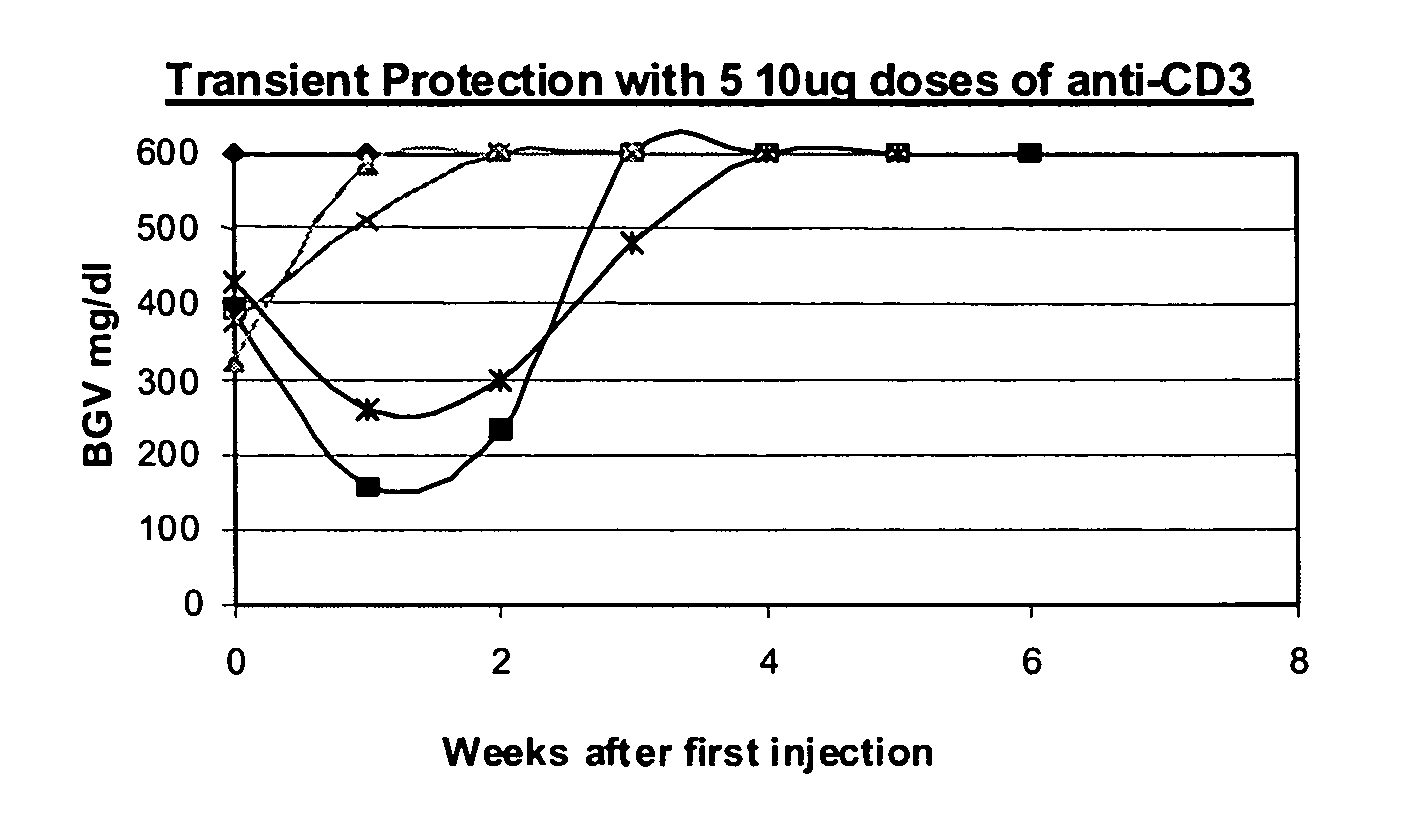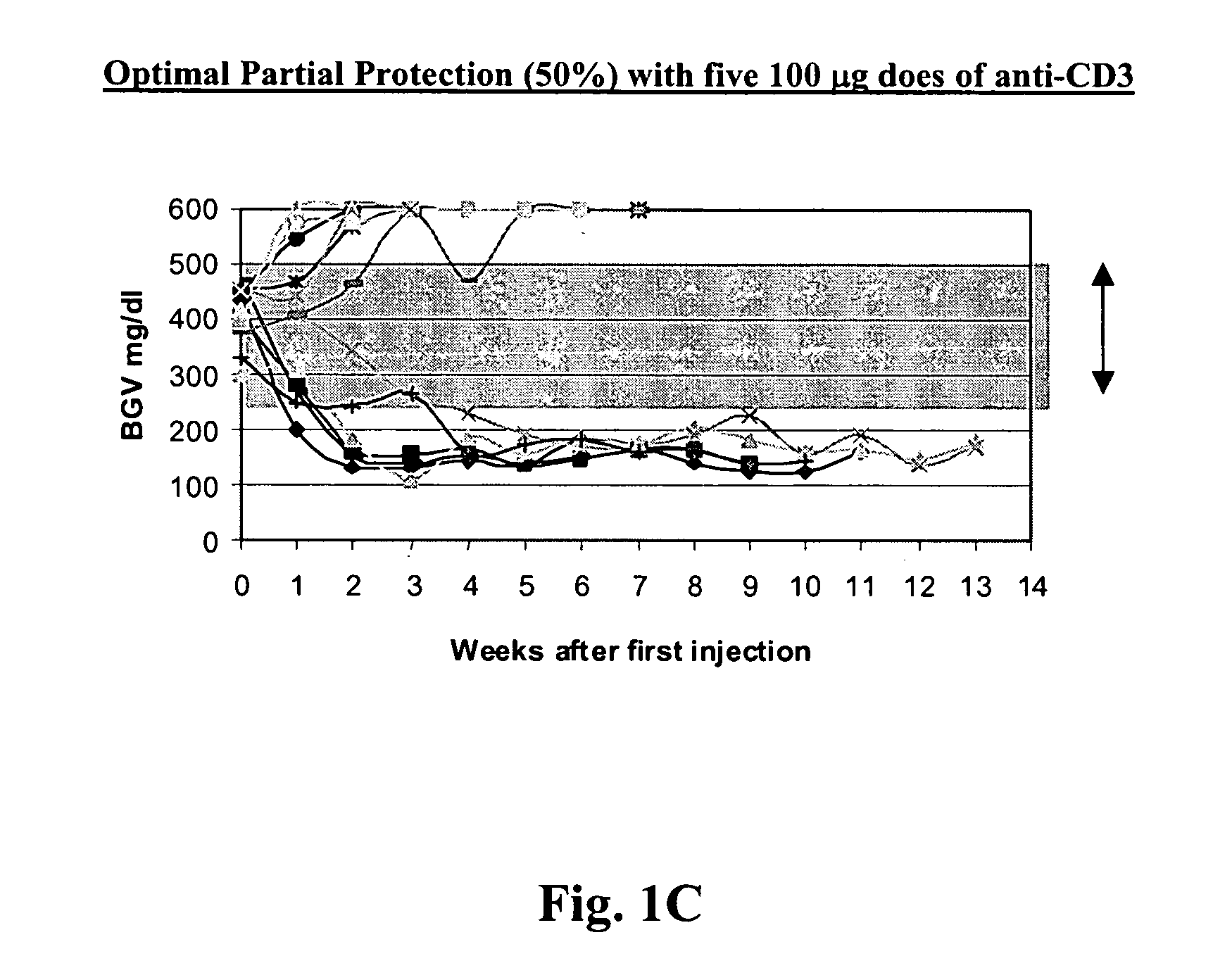Anti-CD3 and antigen-specific immunotherapy to treat autoimmunity
an anti-cd3 and autoimmunity technology, applied in the field of anti-cd3 and antigen-specific immunotherapy to treat autoimmunity, can solve the problems of aggravating existing autoaggressive phenomena, and achieve the effect of increasing immunological tolerance and maintaining long-term toleran
- Summary
- Abstract
- Description
- Claims
- Application Information
AI Technical Summary
Benefits of technology
Problems solved by technology
Method used
Image
Examples
example 1
Experimental Results of Anti-CD3 and Antigen-Specific Immunotherapy to Treat Recent Onset Diabetes in Mice
[0080] The experimental results described below were obtained using the experimental methods in the section “Methodology and Experimental Plans.”
[0081] NOD model: Published studies of anti-CD3 mAb treatment of diabetic mice have shown remarkable efficacy (generally 80%) in permanent reversal of diabetes (Chatenoud et al., Proc Natl Acad Sci USA (1994) 91:123-7; Chatenoud. et al., J Immunol (1997) 158:2947-54).
[0082] The experience in human studies has been that there is retention or even improvement in insulin responses in 71% of patients at 1 year but there is overall a loss of insulin secretory capacity over the second year. Therefore, in order to study the effects of combined immunotherapy in a model that would have relevance to the clinical situation, the anti-CD3 treatment aspect of the combined therapy has been modified in comparison to prior studies using anti-CD3 treat...
example 2
T Regulatory Cells Induced by Anti-CD3 and Self-Antigen can be Used to Treat Autoimmunity
[0123] The data in Example 1 shows that the combined administration of anti-CD3 and autoantigen can have a synergistic effect in inducing tolerance and protecting against autoimmunity. In building upon these results, the present invention includes methods where T regulatory cells that have been exposed to autoantigens and anti-CD3 treatment can be isolated and / or expanded in vitro in order to use the cells themselves for autoimmune therapies. Prior to clinical testing in humans, preclinical testing can be conducted to determine whether any particular combinatorial treatment (i.e., any particular form of anti-CD3 in combination with any particular self-antigen) induces regulatory T cells (Tregs) and / or systemic immune deviation.
[0124] In preliminary adoptive transfer studies (see Table 3 below), using lymphocytes from anti-CD3 treated or anti-CD3+ Ag treated RIP-LCMV donors, only CD4+ cells fro...
example 3
Coadministration with Modified Anti-CD3 Antibodies
[0142] The data from Example 1 shows that combination of anti-CD3 F(ab′)2 systemic therapy with an antigen-specific approach exhibits a clear synergistic effect in treating recent onset T1D. Several autoantigens (DNA vaccine, full protein or peptides) are under therapeutic evaluation in order to determine the best combination giving a maximal protection. Therefore, the model systems for T1D (Examples 1 and 2) can be used to test new reagents for use that mimic the effects that are seen in patients with T1DM treated with anti-CD3 mAb hOKT3γ1(Ala-Ala). The proposed studies in Example 4 pertain to the design of clinical trials in which to test the alterations of immune responses by the combination of antigen with anti-CD3 mAb, provide information on the safety of the combination, and also develop an understanding of the mechanisms involved.
PUM
| Property | Measurement | Unit |
|---|---|---|
| Volume | aaaaa | aaaaa |
| Volume | aaaaa | aaaaa |
| Volume | aaaaa | aaaaa |
Abstract
Description
Claims
Application Information
 Login to View More
Login to View More - R&D
- Intellectual Property
- Life Sciences
- Materials
- Tech Scout
- Unparalleled Data Quality
- Higher Quality Content
- 60% Fewer Hallucinations
Browse by: Latest US Patents, China's latest patents, Technical Efficacy Thesaurus, Application Domain, Technology Topic, Popular Technical Reports.
© 2025 PatSnap. All rights reserved.Legal|Privacy policy|Modern Slavery Act Transparency Statement|Sitemap|About US| Contact US: help@patsnap.com



